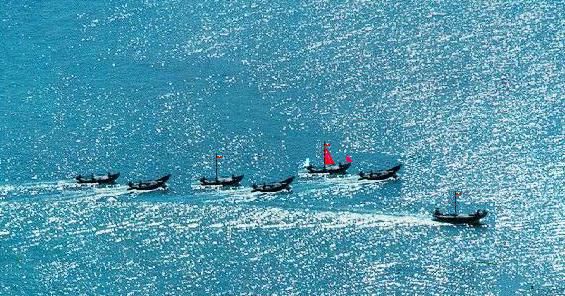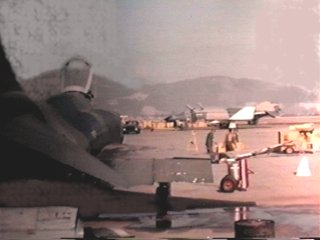

Viet Cong Sampans!
© 1996
South of the DMZ ... 1966: The Forward Air Controller purred along in his O-1 craft (a very light aircraft) spotter plane. Light rain, beaded and instantly streaked to the top of his polished Plexiglas windshield. Clouds were spotty at 5,000 feet. src="https://www.war-stories.com/images/o1-birdog.jpg" lowsrc="https://www.war-stories.com/images/o1-birdog.jpg" align="left" alt="Bird Dog FAC">Clearing the rain, thermal down-drafts and updrafts buffeted the small aircraft causing coffee to slosh out of the pilot's thermos, which was mickey-mouse duct-taped to the door. Fluttering between hilltops, little snatches of green zipped past his view at cockpit level. He enjoyed the sight of deep cratered pockmarks below near and in a shallow stream. A few days earlier, he had called in and directed fast movers to do the submerged sampans hidden beneath the too clear water.
The FAC spiraled slowly upward, drifting out to sea as rain spattered his windshield intermittently. And there they were: seven sampans, like a line of ducks, a half mile off shore and heading for the beach. "What gall," he thought, "flying Viet Cong flags as brazen as if they owned the place!"
He radioed in-the-clear for any fast movers in the area to engage several sampans along the coast. After several repeats, with no takers, an F4 Phantom on its way back to Đà Nẵng answered up. No ordnance ... all ordnance expended! but in the area. The slow mover O-1 hesitated, not seeing what good an F4 could do that had expended its load on inland targets. Still ... maybe he could at least scare the crap out of them.
The FAC guided his BIRDDOG to within sight of where the Phantom should strike the sampans--if he only had ordnance to do so. "FOX-4 ... say again ... report your position and ordnance."
"BIRDDOG . . . FOX-4 ... on station at ten-grand. Zero ordnance ... but I've got time and fuel on station to make a pass with about thirty minutes of playtime before bingo." The FAC realized the F-4 Phantom had two powerful engines, a maximum altitude of 60,000 feet and could excel to speeds of Mach 2. Unfortunately, the sampans would be long-gone into forest-canopied streams within ten-fifteen minutes, which precluded the F4's refueling and rearming. With a shake of his head, the O-1 pilot radioed, "FOX-4, you're clear to engage targets."
The camouflage-painted F-4C spotted the area the FAC had reported the sampans--the junks now a quarter-mile off shore, like beads of raisins scurring toward the beach, as reflected cotton-ball clouds joined their convoy. FOX-4 continued parallel to the beach, more like a knife-line between ocean and stone age jungle, before sharply banking left, and dropping like a roller-coaster. The pilot and guy-in-back felt their rubber-bladders inflate once more against the pressures of G-forces.
It was harder for the slow-mover to spot and track the Phantom with its new cammie paint (all Air Force F-4Cs were painted USAF colors, until mid 1965), but he watched as the F-4 streak down to ocean waves--wispy contrails swirling in its path.
"FOX-4 ... you're taking fire from the shore!" Globs of orange-pink and green wafted lazily from the tree line with no chance of intercepting the fighter-bomber, winking out hundreds of yards behind him. Five miles from target the F-4's radar had easily acquired the string of boats. His Phantom's engines howled in protest as he fired afterburners, quickly racing to Mach-1. Seconds from the target, sea-spray from waves streaked his windshield.
The O-1 pilot watched the sampans at a safe orbit, as the now unseen Phantom approached from the south at the speed of sound. Ten yards off the deck, the F-4's sonic-compress raised a water rooster-tail, like a high-speed water skier's. Another wave preceded the Phantom in the form of accumulated air pressure--a deadly concussion-tsunami-wave. It took a moment for the O-1 pilot to understand what he had witnessed: an F-4 like missile had rocketed across the center of the sampan convoy,
its sonic-wake both parting the sea and raising a water-tail-fist forty or fifty feet high. The center sampan seemed to just disappear. The second and third sampans from center simply settled beneath the roiling waters, while the others sailed on apparently unharmed but no longer in convoy. Then an explosive sonic-sound-report shook the O-1 as if a giant had clutched its wings and shivered violently.
The O-1 watched the F-4--something was wrong--it seemed to bank sharply out toward sea and climb a wobbly path. The F-4 pilot fought for control of the craft with right wing damage. He wanted to see the sampans, but couldn't because of the blind spot in the rear. "FOX-4 ... I ... have battle damage ... were there secondaries?"
The transmission sounded like a voice coming from a cement mixer filled with gravel. "Negative ... negative ... no secondary explosions ... no crossfire from shore! I think... I think you might have collided with one of the sampan's masts--there's a broken mast-section and debris floating in the area!" One lone sampan approached the beach, its rear deck smoldering a trail of heavy smoke, and disappeared beneath overhanging canopy. The last sampan still circled aimlessly as if searching for survivors from another sunken boat, or possibly no one at the rudder.
USAF Đà Nẵng Air Base Crash Crews met the battle damaged F-4. Both pilot and RIO were safe. The F-4's right wing was gouged and twisted upward at a sharp angle (see photo left).Some days later, a small sampan (with a broken mast) was painted on the fuselage.
